#finnish mutation
Explore tagged Tumblr posts
Note
Hey, what is the most common cat color? Is there a particularly rare color? What are some cool statistics/facts about cat colors?
the most common cat color would be black, including black solids and black tabbies! there's a good amount of rare colors and i imagine some people would disagree with me about what is rare, but here's a few:
chocolate and cinnamon (solids)

lilac and fawn (dilute chocolate and cinnamon, solids)

silver smoke, shaded and tipped (different presentations of the inhibitor/silver restriction gene)



golden (another variation on the inhibitor gene)


amber (found in norwegian forest cats)



phoenix mutation


"red on blue" tabby and "pseudo-cinnamon" (i've actually seen some misinformation popping up about these guys recently >_>. a cool-tinted red cat is not necessarily one of these guys!!)


karpati mutation


finnish/salmiak/salt licorice mutation


there's definitely more but i'm tired bye
#what color is that cat#ask#chocolate#cinnamon#lilac#fawn#smoke#shaded#tipped#silver#golden#amber#phoenix mutation#red on blue#pseudo cinnamon#karpati#finnish mutation
666 notes
·
View notes
Note
Have I suggested Kestrelflight yet? If not this is it. I need to suggest him for... reasons.
Here’s your boy!!

KESTRELFLIGHT
“No. I think they were angry with me for staying away. But I had to stay with my Clan, didn't I?”
[Gray-brown ticked spotted tabby with yellow eyes and the Finnish mutation.]
I finally got the chance to draw a standing kitty!! And Kestrelflight is my victim >:)
Design notes!
Speckled!
Tall, tufted ears.
Round face shape, but elongated.
Not shown very well due to his pose, but he’s a ticked tabby; his stripes (spots) are only on his tail, face, and legs.
Lots of fluffed shapes with three tips.
Scarring includes: None.
#warrior cats#warriors#warrior cats design#warrior cats designs#warriors design#warriors designs#warrior cat designs#windclan#kestrelflight#kestrel#flight#spotted ticked tabby#gray#brown#gray brown#finnish mutation#medicine cat
34 notes
·
View notes
Text
Learning new cat colour genetics. Carnelian, kaparti, phoenix, caramel/apricot and pink eyed dilution.
Basically, I learnt most of the genetics of cats and some rodents from a book called the Colour Inheritance in Small Livestock by Roy Robinson. Printed 2013.
But new genes has since been discovered, part 3

Carnelian (kopal, serdolik)- kurilian bobtail
What is it- starts out reddish, then turns pure red with dark tail tip with age (no dark hairs, except tail tip).
Genetics- co-dominant extension gene, ec (sometimes es). In single is golden, in double is Carnelian.
Notes-
Single tabby with Inhibitor gene looks like bimetallic (single self with I is normal smoke)
Single with wideband gene is brownish golden with dorsoventral paleness.
With self colourpoint is taupe points

Kaparti- laperm, lykoi, randonbred cats in carpathians, Transylvanian breed.
What is it- start light and grizzled with white points. With age is almost black, with white points. Sometimes have black face.
Genetics- dominant,
Notes-
Type of roan
Tempreture based points
With colourpoint- is powdery points


Salmiak- randonbred
What is it- originally called Finnish mutation, it causes a roan effect, with a black head and white spots.
Genetics- KIT gene (white mutation). Recessive
Notes-
Found in Finland and Hungary in randonbred cats
Actualy discovered in 2007, despite the gene being discovered as a KIT mutation in a study only recently.
Named for the Finnish salted Liquorice, which its pattern resembles
Originally thought to be a variant of homogenous Kaparti


Phoenix/pseudo cinnamon- Maine coons
What is it- turns red cats into mahogany
Genetics- dominant.
Notes-
Born golden with blue paws and tail
Changes pads colour and brighter eyes
Opposite to extension gene
In self cats the tabby markings are visible as mahogany on bluish background.
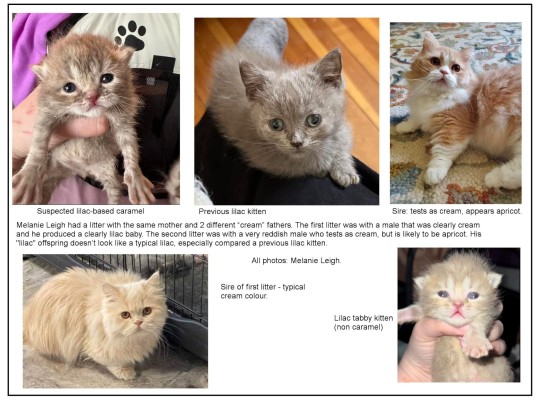

Caramel/apricot- Oriental shorthair, Siamese, Balinese, Oriental Longhairs, Tonkinese, Burmese, Birman and British Shorthair/Longhair
What is it- transforms dilute colours - blue, lilac, fawn, cream - into caramel (in black-based colours) and apricot (in cream cats)
Genetics- Dilute modifier gene (Dm). Dominant in dilute cats. Masked in dense.
Notes-
Have metallic sheen on them.
Doesn't effect dense colours (black, choc, cinnamon, red).
Blue caramel is sometimes called just caramel and cinnamon caramel is sometimes called Taupe.


Pink eyed dilution in cats- two accounts in domestic (both female). In Donskoy (Milkdud)
What is it- It changed black to a fawn/bluish-tan colour and the eyes had a red pupil and gold flecked red/pink irides (iris)
Genetics- recessive, modification of eumelanin. "oculocutaneous albinism with the identification of a splice-site variant in Hermansky–Pudlak Syndrome 5 gene”
Notes-
"Black cat hair (non-agouti) contains numerous small dark brown to black melanin granules uniformly distributed throughout all portions from base to tip of the hair.
Smoke cat hair (non-agouti + inhibitor (silver) gene) has a scarcity of melanin granules at the base of the hair.
Blue cat hair (non-agouti + dilution) has larger basic melanin granules, but still relatively regularly shaped, and a non-uniform distribution of granules.
Chediak-Higashi Smoke cat hair trait has even larger melanin granules than the blue dilution, and they are relatively irregularly shaped. All of the cats were Persian and resembled blue smoke Persians.
The pink-eyed dilute cat hair had very small yellowish-brown melanin granules and very few larger granules. Under the microscope, some lighter banding could be seen on the hairs, but the tip was coloured. The base of the hair was paler than the tip (agouti banding)."
Is not c gene. Like albino
She was a blotched tabby (dominant) with moderate white spotting (dominant) and had a slight kink at the tip of her tail.
Was called flavism and Ukraine chocolate in Donskoy once
Has irregular heats
Has no tapetum lucidum and poor vision
Similar gene as pink-eye mouse and non-syndromic oculocutaneous albinism (OCA) in humans
#cat colours#cat genetics#carnelian#kopal#serdolik#cinnamon#fawn#caramel#apricot#kaparti#hybrid genes#phoenix#pink eyed dilution#ukraine chocolate#Salmiak#finnish mutation
17 notes
·
View notes
Note
Here is a picture of a finnish mutation cat! for the tournament

Oké, here's the deal: since we still don't really know the mutation(s), i can't say that this's the currant scientific agreement; what's more, as far as i'm concerned, this is just the theory of the author of messybeast (although i've seen several people on facebook in cat genetics and karpati cats groups agree), BUT right now it seems like the finnish mutation is the equivalent of nonagouti homozygous karpati with white spotting. (I do think it's a convincing theory.)
Here is the messybeast article with comparisons.
Good news: this means i can absolutely include it! I'll dub it as black karpati with white (i'm still pondering on making homozygous and heterozygous karpatis different competitors), note in the poll that this is the finnish mutation, and use your picture for it. Is this acceptable for you?
#cat genetics#ask and answer#karpati#finnish mutation#black karpati with white#black karpati tuxedo#cat color tournament#cats
23 notes
·
View notes
Text
@felinefractious thanks
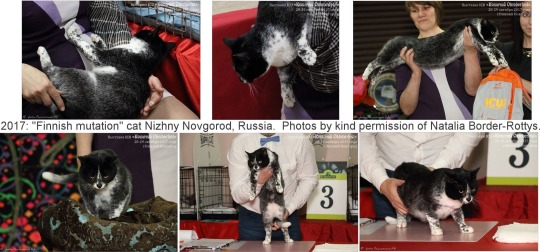
[Image Source: Messybeast]
A New Finnish Flavor of Feline Coat Coloration, “Salmiak,” is Associated With a 95-kb Deletion Downstream of the KIT Gene
Cats with a distinctive white hair pattern of unknown molecular cause have been discovered in the Finnish domestic cat population. Based on the unique appearance of these cats, we have named this phenotype salmiak (“salty licorice”). The use of a commercially available panel test to genotype four salmiak-colored cats revealed the absence of all known variants associated with white-haired phenotypic loci: full White (W), Spotting (Ws) and the Birman white Gloves associated (wg) allele of the KIT proto-oncogene (KIT) gene. Whole-genome sequencing on two salmiak-colored cats was conducted to search for candidate causal variants in the KIT gene. Despite a lack of coding variants, visual inspection of the short read alignments revealed a large ~95 kb deletion located ~65 kb downstream of the KIT gene in the salmiak cats. Additional PCR genotyping of 180 domestic cats and three salmiak-colored cats confirmed the homozygous derived variant genotype fully concordant with the salmiak phenotype. We suggest the newly identified variant be designated as wsal for “w salmiak”.
[Read Full Study]
2K notes
·
View notes
Text

she’s cool i luv her
#spotfur#wc spotfur#thunderclan#warrior cats#warrior cats designs#wc#wc designs#warriors#warriors designs#for anon#she’s designed after cats with a finnish mutation
103 notes
·
View notes
Text
Sitting here eating unheated premade blood pancakes straight from the package, I'm starting to think about just how annoying finnish cuisine must be to someone who didn't grow up in this kind of an environment. Like yeah welcome to the cold north where nothing that grows naturally has any real nutritional value - there's mushrooms growing off the ground for like two weeks in one season and your own weight in mushrooms is like 3 calories. We just eat orc shit made out of whatever can eat the stuff that grows here.
I mean milk isn't that fucked up of a concept if you don't really think about it. Like it's not the bovine titty itself that makes it weird, just that the native population here have a genetic fucking mutation that enables them to digest it in the first place. Sure, lactosis digestion isn't that rare, but I'm still baffled by why people say it like "65% of the world population is lactosis intolerant", like the 35% who are not are somehow the default setting. There was nothing fit for human consumption here that had enough calories to keep people going, so people fucking mutated to consume something that isn't.
And also the things that people just culturally do not eat. Like predators and other omnivores. I don't know if you can get lynx or wolverine meat anywhere, but it took me 20 seconds to find a perfectly credible online store to buy bear meat. I could buy my own weight in canned bear meat right now - it would cost like 7000 euros, but I 100% could if I wanted to.
Almost everything that can be made out of animal products historically has been, because nothing really naturally grows here that's fit for human consumption. This was never a place for an ape. There's just plants that animals can eat, and you eat the animals. And you better eat the whole animal, too. I've spent this week living off blood pancakes and liver casserole. And even things that you wouldn't consider odd if you've grown up around it, but wouldn't even occur to you if you had not. Like gelatin.
I can only imagine how annoying it would be as a muslim moving to Finland and ending up in a town that doesn't have a special Halal shop, so you try to do your shopping in the regular local grocery store, and try to navigate what here even is halal and 80% of the stuff doesn't have any clarification in the packages. And then looking at the self-serve candy and thinking "oh fuck it, I'm going to get myself some fruit and berry gummies for a treat. At least there's no fucking way that these would have pork in it."
And then there's fucking pork in it.
631 notes
·
View notes
Text
Language Playlists
Disclaimer: These playlists predominantly reflect my taste in and knowledge of music. I apologise in advance. Some playlists include songs in other languages including English if deemed appropriate for the playlist. All playlists are works in progress. Playlists in bold are really long.
Multilingual and Continental Playlists
African Music (this used to be a South African playlist and then just mutated)
Foreign Covers
Germanic Music (excluding German and Low German)
Middle Eastern and North African Music
Multilingual Mixtape (contains most of the playlists in this post and a lot more)
North American Music (classic and contemporary indigenous artists)
South Asian Music (mostly but not exclusively Hindi film soundtracks ngl)
Single Language Playlists
Cambodian
Catalan
Chinese
Czech
Finnish
French
Galician
German
Greek
Hawaiian
Hebrew
Hungarian
Irish (Gaeilge)
Italian
Japanese
Korean
Low German and Northern German
te reo Māori
Portuguese
Scottish (Gaelic)
Spanish
Thai
Turkish
Vietnamese
Welsh
Yiddish
Hidden Agenda: Please recommend me music in Romanian and Croatian 🥺 (I also accept other recommendations)
654 notes
·
View notes
Text
a small notice - this coloration has been there for some time! it's called roan, tweed, karpati, salmiak or salt-and-pepper; we just found out now what causes this (a whole chunk of genome missing!)
here's the messybeast article about them :3
http://messybeast.com/roan-tweed.htm
CHAT THEY DISCOVERED A NEW COAT TYPE IN CATS
IT'S CALLED "SALMIAK" OR "SALTY LICORICE" AND IT LOOKS LIKE THIS
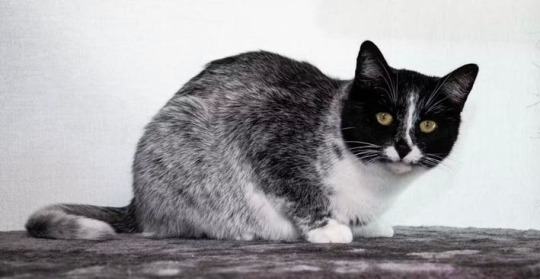
#i remember finding about about them a while ago and being so excited!!!!#pretty powdered cats#edit: oh wait it's updated for the finnish mutation specifically
51K notes
·
View notes
Note
Oh my god they gave Kestrel the Finnish mutation.
It’s a cat coat mutation that only occurs in Finland (with one exception). I think they call ‘em salmiak cats now? Not much is known about the gene cause most cats that have the coat color were either sterilized or were infertile due to population inbreeding
We’ve got chimera Moonpaw confirmed in canon and the designs suggesting Kestrelflight having the Finnish mutation and Sol being a chimera. Someone on that design team has a thing for cat genetics I can tell.
I never knew about this mutation until now that is so cool!!

Artists come and get your Kestrelflight coat references lol
36 notes
·
View notes
Text
Tuuri and Lalli
DOUBLE POST!!! The Finns gotta stick together, right? (Onni was left out.)

First, my baby bird Tuuri. She deserves the world and I'm still sad about her. She and Lalli have been through so much, I just want to see them spend a day in Linnanmäki* or something. (Wait... a future drawing idea?!)


And Lalli... I know he's supposed to be catlike (lynxlike?) but he's just such a goblin. Don't get me wrong, I love a man who can dissect a mutated beast and turn it into a bizarre piece of art.


Also, a fun fact: although I'm Finnish and have been into Finnish mythology my whole life, I only learned about Kallohonka when Lalli started to decorate his Christmas tree (I feel so dumb).
*Linnanmäki is an amusement park in Helsinki, Finland.
#sssscomic#stand still stay silent#lalli hotakainen#tuuri hotakainen#Onni is probably crying himself to sleep right now#gently holds the skulls of my fallen enemies#Let's go decorate the Christmas tree#Yes I know it's a pine tree not a spruce#Let me have this please
42 notes
·
View notes
Note
i heard they invented a new kind of cat, 'salt licorice'. what do u think?
yes the salmiak/salt licorice/finnish mutation!! they actually discovered it in the 2000s in a feral population but just recently identified the genetic mutation that causes it :)


not a geneticist, but from what i understand it’s caused by a large deletion downstream from the KIT gene. the KIT gene does a lot of things, but it’s associated with white spotting in cats! mutations of the KIT gene are also associated with white spotting in other animals :)
917 notes
·
View notes
Text
Piebald in Cats
White spotting grades
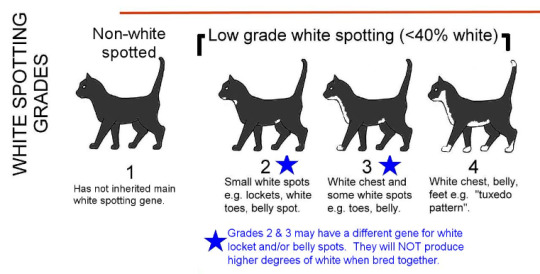
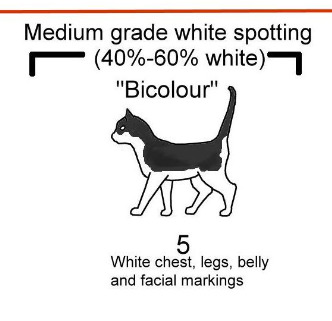
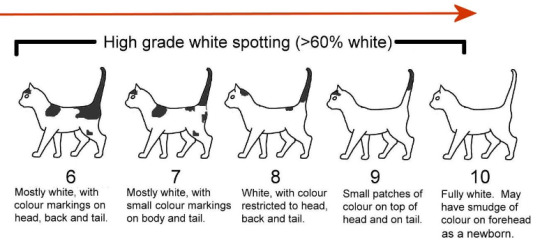
Eye colors + colloquial terms
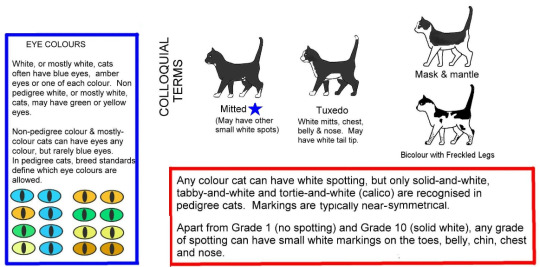
EYE COLOURS White, or mostly white, cats often have blue eyes, amber eyes or one of each colour. Non pedigree white, or mostly white cats, may have green or yellow eyes. Non-pedigree colour & mostly-colour cats can have eyes any colour, but rarely blue eyes. In pedigree cats, breed standards define which eye colours are allowed.
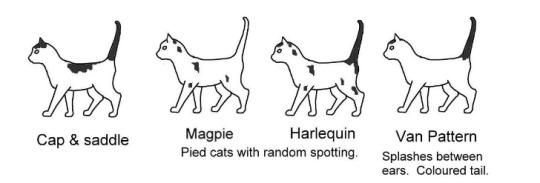
Geneticist terms
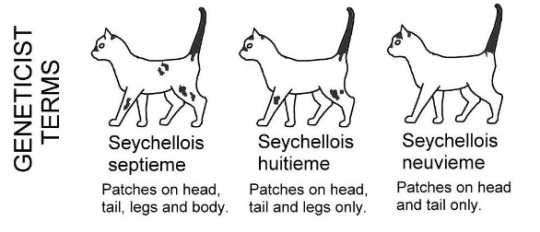
Unusual patterns (developmental)
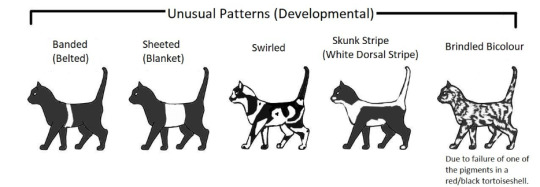
(Brindled Bicolour) Due to failure of one of the pigments in a red/black tortoiseshell.
Roan patterns
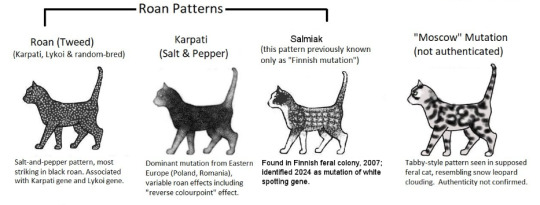
Salt-and-pepper pattern, most striking in black roan. Associated with Karpati gene and Lykoi gene.
Dominant mutation from Eastern Europe (Poland, Romania), variable roan effects including "reverse colourpoint" effect.
Found in Finnish feral colony, 2007; Identified 2024 as mutation of white spotting gene.
Tabby-style pattern seen in supposed feral cat, resembling snow leopard clouding. Authenticity not confirmed.
Age/health related
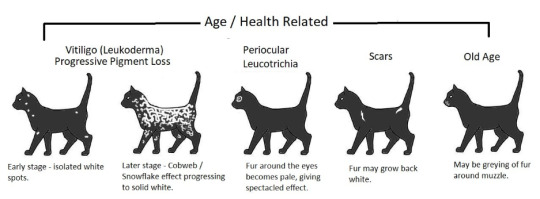
Early stage - isolated white spots.
Later stage - Cobweb/Snowflake effect progressing to solid white.
Fur around the eyes becomes pale, giving spectacled effect.
Fur may grow back white.
May be greying of fur around muzzle.
"Thai" white spotting gene (skunk stripe)

The Thai White Spotting pattern includes a white dorsal stripe and a white tail that may have a band or blotches of black. In Thailand, the pattern is called But-Se-Weis or But-Tal-Lon and various degrees of white—all with a dorsal stripe—are depicted in manuscripts. These patterns can also be seen in native Thai cats. The diagrams below show some of the variations.
Theories of how white spotting works - DISPROVEN
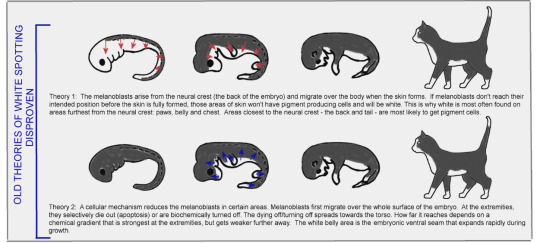
Theory 1: The melanoblasts arise from the neural crest (the back of the embryo) and migrate over the body when the skin forms. If melanoblasts don't reach their intended position before the skin is fully formed, those areas of skin won't have pigment producing cells and will be white. This is why white is most often found on areas furthest from the neural crest: paws, belly and chest. Areas closest to the neural crest—the back and tail—are most likely to get pigment cells.
Theory 2: A cellular mechanism reduces the melanoblasts in certain areas. Melanoblasts first migrate over the whole surface of the embryo. At the extremities, they selectively die out (apoptosis) or are biochemically turned off. The dying off/turning off spreads towards the torso. How far it reaches depends on a chemical gradient that is strongest at the extremities, but gets weaker further away. The white belly area is the embryonic ventral seam that expands rapidly during growth.
Theory of how white spotting works - PROVEN
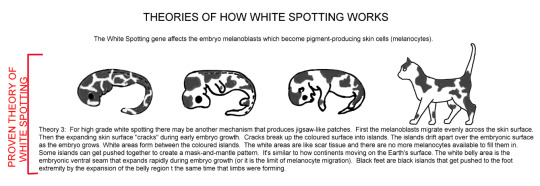
The White Spotting gene affects the embryo melanoblasts which become pigment-producing skin cells (melanocytes).
Theory 3: For high grade white spotting there may be another mechanism that produces jigsaw-like patches. First the melanoblasts migrate evenly across the skin surface. Then the expanding skin surface "cracks" during early embryo growth. Cracks break up the coloured surface into islands. The islands drift apart over the embryonic surface as the embryo grows. White areas form between the coloured islands. The white areas are like scar tissue and there are no more melanocytes available to fill them in. Some islands can get pushed together to create a mask-and-mantle pattern. It's similar to how continents moving on the Earth's surface. The white belly area is the embryonic ventral seam that expands rapidly during embryo growth (or it is the limit of melanocyte migration). Black feet are black islands that get pushed to the foot extremity by the expansion of the belly region the same time that limbs were forming.
CREDITS TO MESSYBEAST CATS
#cats#cat fact#cat drawings#cat facts#piebald cats#piebald#science#theories#interesting#biology#genetics#cat patterns#white spotting gene#cat genetics#cat science#mutation#cat mutation
20 notes
·
View notes
Note
Hello! I’ve been meaning to ask, do you have ideas for how the cats of each clan generally look? Like fur colors, sizes, any additional traits ideal for their environments that you might see more commonly through pure clan blood? I understand this question might take some time to answer so no worries if you can’t get to it right away ^^
Hello!!
This will be added to each Clans page this week, so no worries about asking! Generally, each Clan will have the following Traits be more common:
Shoreshimmer Clan
Webbed Paws ; Developed even further over time with their oceanic swimming tendencies.
Hooked Claws ; Their claws have developed to be more hook-like to aid in catching aquatic prey and for better grasp on the wet rocks of the shore and jettys.
Oily, Water Resistant Coat. Often Two Layers ; soft and downy undercoat for insulation, and the slick outer coat to repel water for their cold and wet environment, especially as they are divers. Not typically too thick as to prevent waterlogging.
Dilute Coat Colors ; Often Blues and Lilacs. Gingers and genetically red cats are more uncommon.
Silver Coat Colors ; Caused by an Inhibitor Gene, different from dilute coats.
Patterns ; Ticked Tabby, Classic Tabby, and Sokoke Tabby are all the most common. Smoke and ghost tabby patterns are quite common as well.
White Spotting ; Typically lower in amount or absent.
Thicker Body Type ; Powerful Legs to Aid in Swimming and higher fat content due to the proximity of the ocean. Thick and rudder-like tail. Their faces tend to be a bit more rounder than average.
Smaller and more Rounded Ears ; to keep water out.
Mutations ; Polydactylism is common among Shoreshimmer Cats, often aids in grip and steadiness along the slippery rocks.
Torrentfall Clan
Webbed Paws ; Same as Shoreshimmer, developed more webbing between their toes to aid in swimming.
Two Layered Coat ; Again, same as Shoreshimmer, due to their aquatic tendencies, two layered coats are quite common. The different being with Torrentfall, their outer layer is more semi-repellent and sleeker, as opposed to oily. They may also have thicker fur types than Shoreshimmer.
Solid Coat Colors ; Varies heavily and runs the full gamut between black to fawn, including chocolate and cinnamon. Dilute tortoiseshells are common.
Silver Coat Colors.
Patterns ; Darker points such as Mink, Seal, or Sepia are common. Mackerel, Classic, Marbled Classic and spotted are common Tabby Patterns. Russian Topaz coats and eyes are quite common as well.
White Spotting ; High gamut between High Spotting to None.
Stockier and Rigid Body Type ; due to risk of fall, they tend to be built Stockier with heavier muscle and high fat content, somewhat helping prevent grievous fall injury. Long and plume like tails to aid in swimming. Strong shoulders, legs and neck. Their faces tend to be more blocky and square.
Smaller and more Rounded Ears ; to keep water out.
Mutations ; Polydactylism is also quite common in Torrentfall for the same reasons as Shoreshimmer. Very rarely one might find the Finnish coat mutation. Heterochromia is quite often, a bit moreso in Torrentfall than other Clans.
Mistshroud Clan
Large Paws and Pads ; Developed to stalk silently through the forest, especially during snowfall season.
Sleek Fur ; The fur among them tends to be sleeker and long, lacking the dual layers that Shoreshimmer and Torrentfall cats commonly have.
Coat Colors ; Varies commonly between black, dilute blue and lilac, and silver. Their coats tend to be lighter to blend in with their misty environment.
Patterns ; Points are extremely common, as well as Shaded, Smoke, and Tipped. Solid coats are also quite common, and Tabby patterns tend to be less commonly found among them. You may rarely find the Finnish mutation or tweed among patterns and coats.
White Spotting ; Averagely they will have medium to high white spotting, with a good chunk being almost all or entirely white. Also more common to have "interesting" white patterns, such as the white back stripe and van patterns.
Average Build ; Large ears to help take in more sound, longer whiskers than average to aid in navigation, and long legs to aid in traversing their territory. Their legs and tail are long, and their paws have developed to be larger for more silent stalking, possibly a trait introduced in history due to a lynx or bobcat. May vary between average to a smaller size generally. Tufted ears are common. Their faces tend to be thinner and angular.
Mutations ; Albinism and Leucism are common among them, as well as Vitiligo coats. The Finnish coat mutation may rarely be found here as well. Heterochromia can also be found here quite commonly.
Thornrush Clan
Strong, Long Fangs and Claws ; To aid in ripping apart tough carcasses such as elk and through plant matter with more ease.
Short Fur ; Lacking the same wet and damp environment that the aforementioned groups do, Thornrush Clan cats tend to have shorter but thick fur and tougher skin, as to protect themselves from the thorns of their environment. Unlike Torrentfall and Shoreshimmer, Thornrush will take on a winter coat and shed it during the summer, maintaining their sleek coat appearance.
Coat Colors ; Very commonly chocolate, cinammon, ginger, and the dilutes of those colors (lilac, fawn, cream, gold). Golden genes (wide-band)((different from the gold derivative of ginger)), and Sunshine coats are relatively common as well. Tortoiseshells of the aforementioned colors are quite common as well.
Patterns ; Tabby markings of all sorts can be found in Thornrush cats. Points are a bit rarer but can be found due to the shared heritage between themselves and Mistshroud.
White Spotting ; low to medium white spotting, higher white spotting tends to be less common.
Large Build ; In contrast to Mistshroud, cats of Thornrush are often larger in stature, and built with lean muscle. Their pawpads are thick and resistant to rough terrain. Tufted ears are common, though their ears are average sized in comparison to Mistshroud. Their faces tend to be broader and angular.
Mutations ; Bobbed tails and no tails are commonly found among cats of Thornrush, as well as curled ears. Wiry fur can be found here commonly as well.
Skyreach Clan
It is to be noted that as the youngest of the Clans, Skyreach has the least dramatic amount of change from their parental Clans, sans a few traits that have been taken on by outsiders that have joined due to Skyreach being the most welcoming of them.
Long Tails and Wide Ears ; Skyreach Clan has developed long tails to help maintain balance along the rocky outcroppings of their home, and large ears to take in and maintain more warmth during sunny days.
Thick but Sleek Fur ; Due to their shared parent Clans, Skyreach cats will have thick but sleek fur, lacking the dual layer water repellent layer that Torrentfall does but having the thickness of Mistshrouds fur.
Coat Colors ; A very wide variety of coat Colors can be found here, none in particular stand out further than others due to not only their shared parental Clan traits, but the traits of loners and kittypets.
Patterns ; Again, a wide variety of patterns can be found here due to the Clans genetic makeup, but spotted tabby patterns and points will tend to crop up a bit more.
White Spotting ; Extremely wide gamut of white spotting can be found here, ranging from none to entirely white.
Thin and Lean Build ; They will more than typically have longer legs with smaller paws, as the large paws of Mistshroud have mostly faded out due to the lack of need for stealth and silence among the Clan. Webbed paws have all also but faded out, with a rare few having either or. They sport large ears and angular faces and long tails that have pluming fur or are thin and whip-like.
Mutations ; Any can be found here, none taking lead over any other, aside from maybe albinism being a bit more common.
These are just suggestions of course, you do not have to make your cats fit into all or any of these categories if you so wish! These are just the most commonly found physical traits and builds, each having been suited for their environments.
10 notes
·
View notes
Text

What if. What if they were cats. Today on rain code art that caters to me and me only
Some notes:
The ahoges are now adapted into ear tufts. I don't know how common or if possible are ear tufts on short-haired cats, so, assume artistic liberties or something. Rule of Pretty
Yuma now has blue eyes, because 1) I'm making all the charas have realistic cat genetics and bright purple eyes just. aren't really possible in cats unless they have albinism, and even then it's just a slight tint, and 2) he's a colorpoint now, and all colorpoint cats have blue eyes! That is because colorpoints have a form of partial albinism, and because of that all their eyes are blue because the blue layer in the eye (that's common to all cats) is not covered by another color :)
All the fur flying around Yuma is because of stress, as cats shed excessively when they're having a terrible time. Soon the whole Kanai Ward is covered in Kokohead memorabilia
Makoto gets a new mask and is now perpetually owo'ing. As soon as he takes it off he reveals the face of the most miserable cat alive after hours upon hours of getting whisker fatigue (causing sensory overload in cats, for ex. when rubbing whiskers on the side of a bowl that's too deep) wearing it. As for the fur, I have no idea how he dyes it that way and I will not make up one
Gave Kurumi appaloosa mutation (that I constantly mix up with finnish mutation in my head) to resemble her freckles :) she's a spotty kitty now :33
Also wanted to imitate a braid with her tail but couldn't really make it work, so instead it's now thin at the base and tufty at the end. Can you. Can you see it (also gave her detailed shading because she's a very special girl that deserves it)
Yomi & Martina are probably going to be next, I already have a very clear image of cat Yomi rotating in my head. To go along with my transmasc Yomi headcanon, and keep him dying his hair, he is now a black-red calico that paints over his black patches with orange dye to look like a bicolor. As torties/calicos are almost always female unless something funky is going on. To win boy kitty passing. Something which is possible to fail at
#Yeah I'm a cat genetics nerd what about it :///////#GRIPS YOUR SHOULDERS STARES AT YOU WITH MY BLOODSHOT EYES PLEASE PLEASE ASK ME ABOUT CAT GENETICS. CATS IN GENERAL. CATS👍WJAT A CREATURE#mine#rain code#art tag#makoto kagutsuchi#Yuma kokohead#Kurumi wendy
30 notes
·
View notes
Text
Raid captain Idea i got from daydreaming
Any mob picking up a raid captains flag
I got this idea from daydreaming as a nitwit and picking up a raid captain flag in diffrent way [stumbling in a forest, diffrent place, on my front door staircase with a pillager hitting their head the stairs trying to get it]
Oc and implied death
I also thought of one of my ocs from craft an ask, 'Coffin eyes' asexually reproduced child[from autemm fog fic, on the chapters 'docters notes' about witch reproduction and mutation]. Their kid has witness a raid captain coughing up blood, couse poisoned.
Wich I'd doodled an idea on "Educational Patrol"
Unfinished doodle I'm planning to draw some cute little outfit, mb a little cape.

But i have to go to the dentist so I don't promise to finnish this
But chapter one is the pillager crew trying to comfort a child as I try to kill this mosquito [I've slapped that suckered a couple of times and the tennis racket that electrics is giving a rancid smell, while the fly is still alive. It somet8mes looks like a mosquito]
4 notes
·
View notes